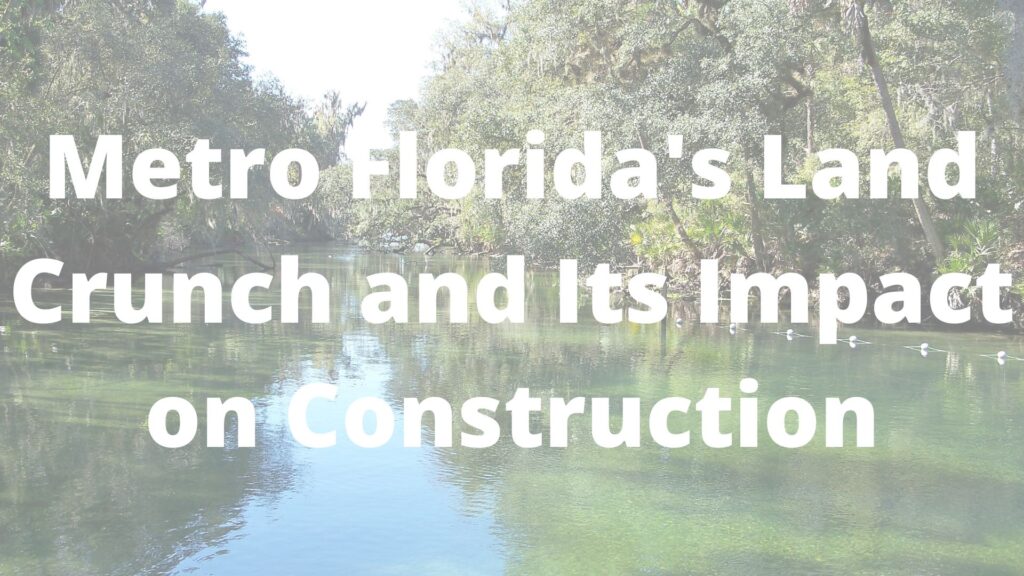
Metro Florida, a region synonymous with rapid growth and vibrant development, is facing a significant challenge: a burgeoning land shortage. The Sunshine State’s allure, fueled by tourism, retirement migration, and economic opportunities, has created a relentless demand for housing and commercial spaces. However, with limited available land, the construction industry is grappling with escalating costs, material shortages, and a changing landscape.
The Numbers Don’t Lie:
According to recent data from the University of Florida’s Bureau of Economic and Business Research (BEBR), several metro Florida counties are experiencing significant population growth. For example:
Orange County: Projections indicate a substantial increase in population over the next decade, placing pressure on existing land resources.
Miami-Dade County: Already densely populated, Miami-Dade faces immense pressure to accommodate further growth, leading to vertical development and rising land prices.
Lee County: Rapidly growing, this area is seeing a massive demand for housing, leading to a quick decrease in available land.
These statistics translate to a simple equation: more people, less land. This scarcity is driving up land acquisition costs, making it increasingly difficult for developers to find affordable sites.
Case Studies: The Impact on Local Communities:
Sarasota: Sarasota County has seen a surge in demand for waterfront properties and suburban housing. This has led to intense competition for available land, resulting in higher housing prices and a shift towards denser development. Local builders are facing challenges in finding suitable lots, and the price of those lots are exponentially higher than they were a few years ago.
Orlando: Orlando’s booming tourism and tech sectors have fueled rapid expansion. Developers are increasingly turning to infill development and redevelopment projects to maximize land use. This has created challenges for preserving green spaces and managing traffic congestion.
Fort Myers: Fort Myers and surrounding areas are facing a critical land shortage, with developers scrambling to secure buildable plots. This has led to increased competition for materials, and a rise in material costs. Also, the destruction of local habitat for housing has become a major concern.
Impact on Florida’s Construction Industry:
The land shortage has profound implications for Florida’s construction industry:
Increased Construction Costs: Higher land prices directly translate to increased construction costs, making housing less affordable for residents.
Material Supply Chain Disruptions: As developers compete for limited resources, the demand for construction materials, including lumber, concrete, and steel, has surged. This has led to supply chain disruptions and price volatility.
Diminishing Local Wood Supply: Florida’s natural resources, including its forests, are under pressure. The demand for lumber for construction, coupled with land clearing for development, is depleting local wood supplies. This necessitates reliance on imported lumber, further driving up costs and contributing to environmental concerns.
Shift Towards Vertical Development: The scarcity of land is prompting a shift towards vertical development, with more high-rise buildings and multi-family housing projects emerging. This requires specialized construction techniques and materials, adding complexity and cost to projects.
Labor Shortages: The increased demand for construction projects, coupled with a limited labor pool, is exacerbating labor shortages in the industry.
Environmental Impact: The clearing of land for development can have significant environmental consequences, including habitat loss, increased storm water runoff, and reduced biodiversity.
Looking Ahead:
Addressing the land shortage in Metro Florida requires a multi-faceted approach. This includes:
- Implementing smart growth strategies that prioritize infill development and urban redevelopment.
- Investing in infrastructure improvements to support higher-density development.
- Preserving green spaces and protecting natural resources.
- Exploring alternative construction materials and techniques to reduce reliance on traditional lumber.
- Supporting workforce development programs to address labor shortages.
Metro Florida’s land crunch is a complex challenge with far-reaching consequences. By adopting sustainable development practices and investing in innovative solutions, the region can mitigate the impact of land scarcity and ensure a prosperous future for its residents.
Resources:
University of Florida Bureau of Economic and Business Research (BEBR): bebr.ufl.edu
Florida Department of Economic Opportunity: floridajobs.org
Local County Property Appraiser websites.
Local city planning and zoning department websites.
Florida Department of Agriculture and Consumer Services.
 John Caravella Esq., is a construction attorney and formerly practicing project architect at The Law Office of John Caravella, P.C., representing architects, engineers, contractors, subcontractors, and owners in all phases of contract preparation, litigation, and arbitration across New York and Florida. He also serves as an arbitrator to the American Arbitration Association Construction Industry Panel. Mr. Caravella can be reached by email: [email protected] or (631) 608-1346.
John Caravella Esq., is a construction attorney and formerly practicing project architect at The Law Office of John Caravella, P.C., representing architects, engineers, contractors, subcontractors, and owners in all phases of contract preparation, litigation, and arbitration across New York and Florida. He also serves as an arbitrator to the American Arbitration Association Construction Industry Panel. Mr. Caravella can be reached by email: [email protected] or (631) 608-1346.
The information provided on this website does not, and is not intended to, constitute legal advice; instead, all information, content, and materials available on this site are for general informational purposes only. Readers of this website should contact their attorney to obtain advice with respect to any particular legal matter. No reader, user, or browser of this site should act or refrain from acting on the basis of information on this site without first seeking legal advice from counsel in the relevant jurisdiction. Only your individual attorney can provide assurances that the information contained herein – and your interpretation of it – is applicable or appropriate to your particular situation. Use of, and access to, this website or any of the links or resources contained within the site do not create an attorney-client relationship between the reader, user, or browser and website authors, contributors, contributing law firms, or committee members and their respective employers.
